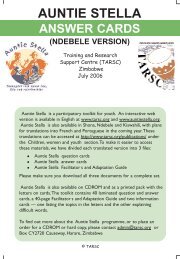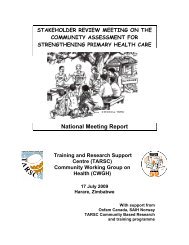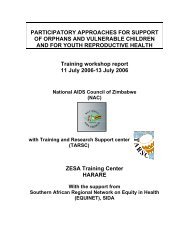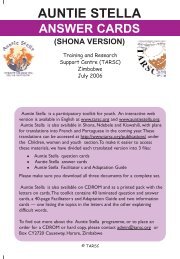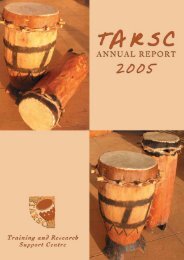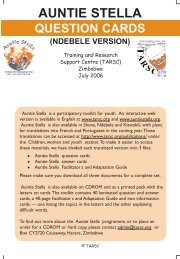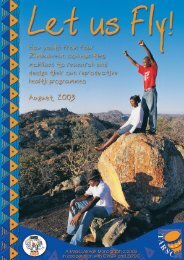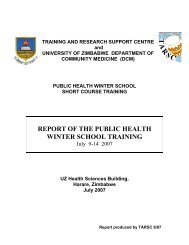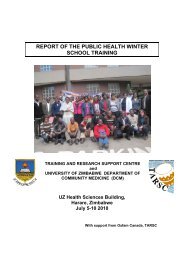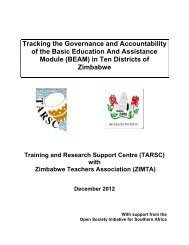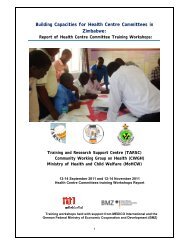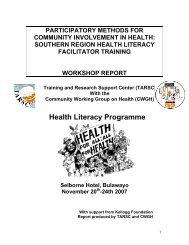HLregional meeting09.pdf - Training and Research Support Centre
HLregional meeting09.pdf - Training and Research Support Centre
HLregional meeting09.pdf - Training and Research Support Centre
You also want an ePaper? Increase the reach of your titles
YUMPU automatically turns print PDFs into web optimized ePapers that Google loves.
• Founded on collective, shared <strong>and</strong> common vision for primary health care oriented, people<br />
centered health systems that promote socially permissible systems for information<br />
exchange, vertically <strong>and</strong> horizontally<br />
• Health Literacy is established on values of all stakeholder participatory planning to<br />
encourage more sustainable resource use. Involvement of all key stakeholders including<br />
communities supports social cohesiveness, cooperation thus pooling ideas, resources, labor<br />
<strong>and</strong> talent to achieve communal projects that are important to health.<br />
• Health Literacy is designed in such a way that it replicates, it is people led, people driven<br />
<strong>and</strong> ‘responds to issues that affect them <strong>and</strong> are more likely committed to find <strong>and</strong><br />
implement solutions on their own ways, than those imposed by external agencies’. Health<br />
Literacy is bridging gaps between knowledge <strong>and</strong> practice, addressing social justice <strong>and</strong><br />
enabling people to gain control over determinants of their health<br />
Lessons learned about the way the programme is sustained<br />
• It is encouraging that Health Literacy embraces the vision of ‘integration’ of physical,<br />
societal <strong>and</strong> political perspectives about moving towards a comprehensive, people centered<br />
system approach The essence of the integrative vision is characterized by learning,<br />
interdisciplinary enabling processes that embrace uncertainty, complexities <strong>and</strong> dynamics of<br />
change in order to balance social, economic <strong>and</strong> physical sustainability<br />
• Health Literacy reflects a clear <strong>and</strong> coherent common agenda (or set of priorities) among<br />
stakeholders. For this reason it contributes to partnership building, trust building <strong>and</strong> this<br />
builds towards programme sustainability including local underst<strong>and</strong>ing of this.<br />
• Health Literacy embraces the ‘triangulation principle’ (multiple sources of information <strong>and</strong><br />
methods), <strong>and</strong> links together various resource people <strong>and</strong> knowledge sources. This builds<br />
trust, increases confidence in results by adding new information, assessing <strong>and</strong><br />
crosschecking, reflecting <strong>and</strong> acting from multiple ‘points’, including various sources, various<br />
methods or in various conditions. The explicit cooperation at every level in Health Literacy<br />
with local stakeholders on an on-going basis creates the opportunity for distortions or<br />
misunderst<strong>and</strong>ings to be corrected relatively rapidly <strong>and</strong> easily. Relatedly, activities <strong>and</strong><br />
results are more widely accepted as they build on <strong>and</strong> link the ‘best of diverse resource<br />
angles’<br />
• Health Literacy is based on iterative learning <strong>and</strong> feedback loops <strong>and</strong> there is a two-way<br />
sharing of information (local people take a lead role in sharing of experience <strong>and</strong> knowledge,<br />
facilitation, investigation, analysis <strong>and</strong> learning, action <strong>and</strong> reflection), sharing of information<br />
<strong>and</strong> ideas, triangulation, the quality of behavior <strong>and</strong> interaction, rigorous observation <strong>and</strong><br />
reflective judgment <strong>and</strong> action. For this reason it allows for the proper identification of<br />
stakeholders, community structures, <strong>and</strong> provides space for the adequate representation of<br />
stakeholders that provide stability <strong>and</strong> sustainability, recognition <strong>and</strong> acknowledge to<br />
community roles in Primary Health care.<br />
Lessons learned about people centered health systems<br />
• They invest in people as the primary beneficiaries <strong>and</strong> participants of the Health system.<br />
This promotes use of locally available resources to advance health through increased<br />
knowledge on prevention, effective <strong>and</strong> practical prevention strategies.<br />
• People centered health systems can be achieved through huge investments at primary care<br />
level thus the need to revitalize Primary health care through Health Literacy. Investment in<br />
Primary health care ultimately reduces the total cost for health (reduced disease burden,<br />
lees people needing curative services)<br />
• People Centered Health systems are founded on a turf layer of trust. Health Literacy builds<br />
trust, <strong>and</strong> promotes two-way communication between communities <strong>and</strong> other actors in the<br />
Health system. Accordingly access to <strong>and</strong> uptake of health services is significantly<br />
increased.<br />
Lessons learned about social empowerment in health<br />
• Health Literacy is an efficient social empowerment process. It is encouraging to note that the<br />
values <strong>and</strong> ideas of social empowerment are synonymous with the Health Literacy process.<br />
Social empowerment processes should be people initiated, people driven, people led,<br />
dynamic, sustainable, robust, flexible <strong>and</strong> adaptive, so is Health Literacy.<br />
• Constitutional entitlements, health laws, community structures, health freedoms <strong>and</strong> health<br />
rights that enable people to organize power to control their own resources should support<br />
social empowerment processes.<br />
5




